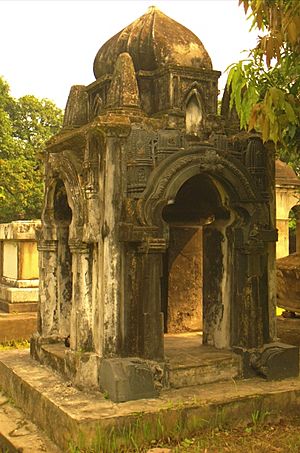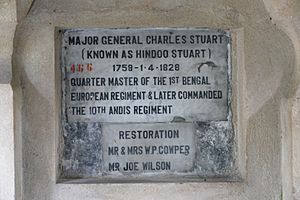Charles Stuart (East India Company officer) facts for kids
Quick facts for kids
Charles Stuart
|
|
|---|---|
| Nickname(s) | Hindoo Stuart |
| Born | c. 1758 Kingdom of Ireland |
| Died | 31 March 1828 Calcutta, British India |
| Buried |
South Park Street Cemetery, Calcutta
|
| Allegiance | British Empire British India |
| Rank | Major General |
| Relations | Thomas Smyth (Limerick MP) Robert Stuart (British Army officer) James Stuart (artist) |
Charles Stuart (around 1758 – March 31, 1828) was a British officer. He served in the East India Company Army in India. He became famous for being one of the few British officers who truly loved and adopted Hindu culture. Because of this, people called him Hindoo Stuart.
Stuart also wrote books and newspaper articles. He praised Hindu culture and traditions. He encouraged Europeans in India to learn from them. He disagreed with missionaries who criticized Indian ways of life. His story is even mentioned in the book White Mughals by William Dalrymple.
Contents
Early Life and Family
Charles Stuart was born in Dublin, Ireland, around 1757 or 1758. His father was said to be Thomas Smyth. Thomas Smyth was the Mayor and a Member of Parliament for Limerick City.
Charles Stuart had several nephews who became well-known. These included Robert Stuart, a diplomat, and James Stuart, a naturalist and surgeon. Not much is known about Charles Stuart's early years. However, his later writings show he likely had a good education. He probably studied Latin and poetry.
Life in India
When he was 19, Stuart moved to India. He stayed there for the rest of his life. He joined the army of the East India Company. He started as a cadet and moved up through the ranks. By 1803, he was a Lieutenant-Colonel. There are no records of him fighting in any major battles.
Becoming 'Hindoo Stuart'
Stuart loved Hindu culture very much. He openly supported it in his writings and talks. This is how he got his famous nickname, Hindoo Stuart. One of his biographers, V. C. P. Hodson, wrote that Stuart "had studied the language, manners, and customs of the natives of this country with so much enthusiasm, his intimacy with them ... obtained for him the name of Hindoo Stuart".
Stuart adopted many Hindu customs in his daily life. For example, he bathed in the holy Ganges River in Calcutta every morning. He also collected many Hindu deities and religious statues. Archie Baron, in his book An India Affair, noted that Stuart's love for Hinduism was very public. He said it didn't seem to harm his career.
Stuart quickly started wearing Indian clothes. This became his usual clothing when he wasn't on duty. He also encouraged his Indian soldiers, called sepoys, to wear full moustaches in the Indian style. His commander even "ticked him off" for letting his sepoys wear "Rajput moustaches or brightly coloured caste marks". Stuart believed Indian clothes were best for India's weather. He strongly encouraged other Europeans to wear them too.
His Unique Ideas
Stuart often wrote newspaper articles about Indian clothing. He made "frequent and vigorous" contributions to the Calcutta Telegraph in 1800. He especially urged European ladies in India to wear the sari.
He even published a funny book called The Ladies Monitor. In it, he wrote letters praising the "elegant, simple, sensible" Indian saris. He compared them to the tight, uncomfortable European corsets. He even joked that wearing iron corsets made women more likely to be struck by lightning! He also said that if women stopped using iron corsets, there would be more iron for farmers in Bengal to make wagon wheels.
In 1804, Stuart went back to the British Isles. He returned to India in 1809. During this time, his pay dropped a lot.
In his book Vindication of the Hindoos (1808), Stuart criticized European missionaries in India. He believed that Hinduism already made its followers "a sufficiently correct and moral people". He wrote that in the "vast ocean of Hindu mythology," he found "Piety... Morality... and... the most complete and ample system of Moral Allegory". Stuart warned about the dangers of missionaries trying to convert Indians. He called it "impolitic, inexpedient, dangerous, unwise and insane". He even asked, "if their religion is insulted what confidence can we repose in the fidelity of our Hindu soldiers?" Some people say this warning was a sign of future problems, like the Mutiny of 1857.
After returning to India in 1809, Stuart continued to rise in the East India Company. He became a Colonel in 1811 and a Major-General in 1814.
Collecting Indian Treasures
During his life, Stuart collected many items from India and other parts of Asia. These included statues, weapons, armor, furniture, and books. He kept them in his home on Wood Street in Chowringhee, Kolkata. He opened his collection to the public. The most special part of his collection was hundreds of Hindu, Buddhist, and Jain sculptures from all over India. Some of these items were later found to have been taken from temples. For example, in 1810, two inscriptions from Bhubaneswar were given to the Asiatic Society of Bengal by a "General Stewart". These were later returned to their original temples.
His Lasting Impact

Even though Stuart often spoke about becoming Hindu, he didn't completely reject Christian beliefs. He believed the Hindu deity Krishna was like the Spirit of God. He thought Krishna came to Earth to help people. Stuart felt this idea was "not very inconsistent with Christianity". He was happy to be buried in an Anglican cemetery, even with his favorite idols buried alongside him.
Stuart passed away on March 31, 1828. He was buried with his deities at the South Park Street Cemetery in Calcutta. His tomb was designed to look like a Hindu temple. In his will, he left most of his money to his family in Ireland. He also left smaller amounts to his Indian servants.
After Stuart's death, his large collection of old items was sold at Christie's auction house in London. Most of it was bought by a person named J. Bridge. When Bridge died, the collection was given to the British Museum. In 2018, an Indian news site asked the British Museum about returning one piece, a sandstone sculpture of the Hindu deity Harihara. The museum replied that they believe it helps visitors to see "the whole world under one roof". They said the museum's strength is showing many cultures together. This helps visitors compare cultures and understand how we are all connected.
Published works
- Observations and Remarks on the Dress, Discipline, Etc. of the Military (1798)
- The Ladies Monitor, Being A Series of Letters First published in Bengal on the Subject of Female Apparel Tending to Favour a regulated adoption of Indian Costume And a rejection of Superfluous Vesture By the Ladies of this country With Incidental remarks on Hindoo Beauty, Whale-Bone Stays, Iron Busks, Indian Corsets, Man-Milliners, Idle Bachelors, Hair-Powder, Waiting Maids, And Footmen (1802)
- Vindication of the Hindoos (1808)


